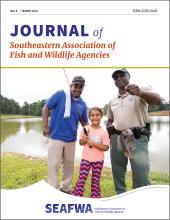SEAFWA Journal Volume 9 Table of Contents
Fisheries
Steven J. Rider, J. Eric Ganus, Travis R. Powell, Gregory T. Miles
1 Feasibility of Initiating a Commercial Fishery for Paddlefish in Alabama Reservoirs of the Tennessee River
Sean C. Lusk, T. Brett Hobbs, Kelly Winningham, D. Colton Dennis, Jeffrey Buckingham, Christopher R. Middaugh, Ronald L. Johnson
8 Evaluating the Genetic Response Following Introduction of Florida Largemouth Bass into Two Large Arkansas Reservoirs
Christopher R. Middaugh, Sean C. Lusk, Cody...
